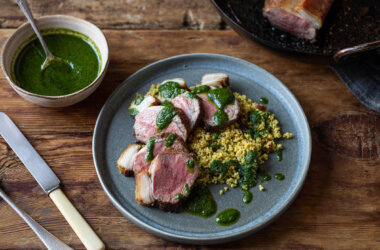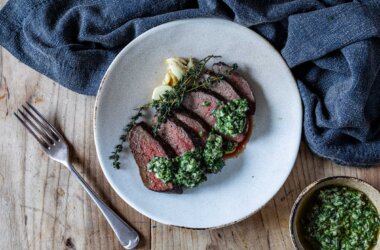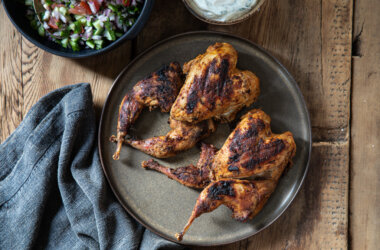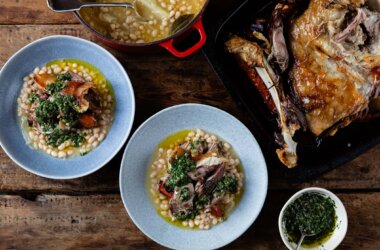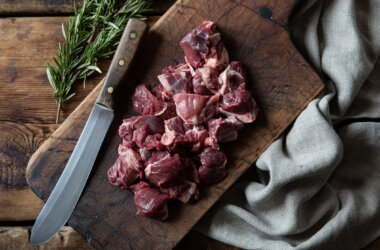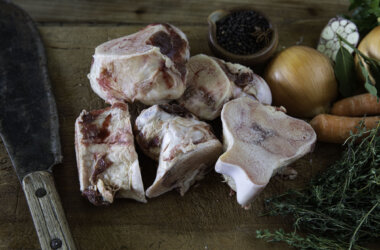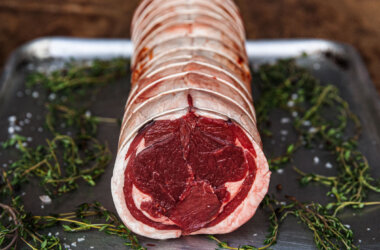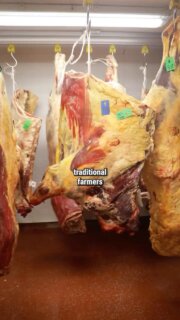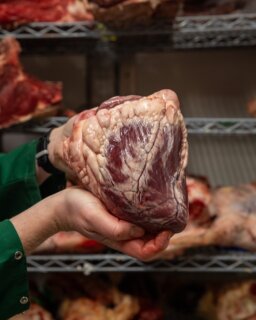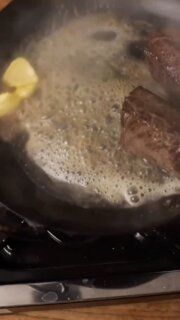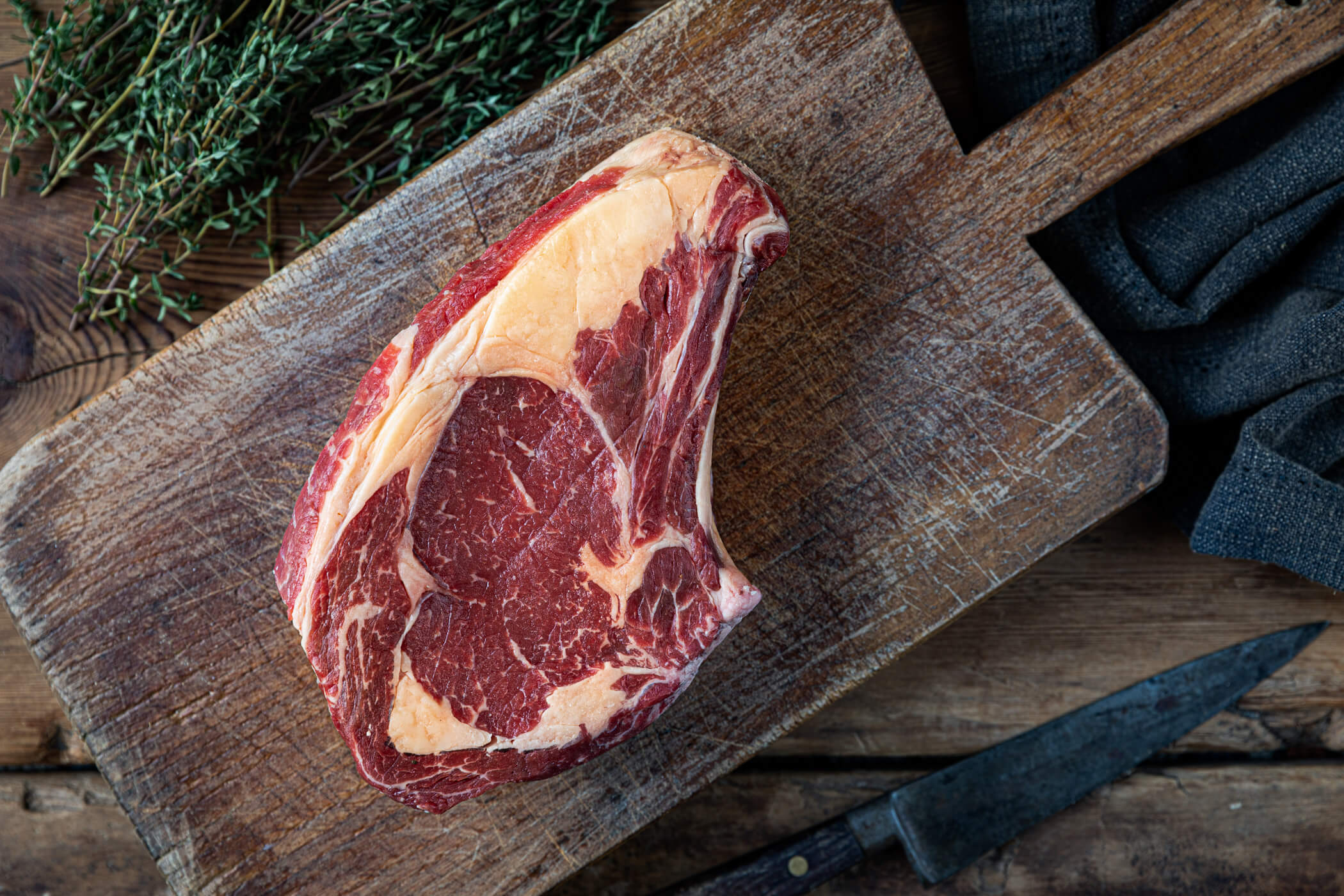
What is Cote de Boeuf?
How to Cook Cote de Boeuf: Translated from French, cote de boeuf simply means ‘rib of beef,’ though it has become synonymous with a bone-in ribeye steak. This elegant and revered cut, taken from the beef rib, is a staple of classic French gastronomy and is equally celebrated across Europe. When sourced from Yorkshire’s finest grass-fed cattle, it delivers an unparalleled depth of flavour and succulence, making it a standout choice in our Prime Steak collection.
Characterised by its rich marbling, deep flavour, and succulent texture, cote de boeuf is cooked on the bone, enhancing its juiciness and tenderness. Often considered the ultimate steak, it’s a show-stopping cut that delivers restaurant-quality results whether grilled over charcoal, seared in a cast-iron pan, or roasted to perfection.
For those looking to take it outdoors, our How to BBQ Cote de Boeuf guide is available now on the Journal — perfect for achieving a smoky crust and blushing pink centre over hot coals.
Cote de Boeuf Cooking Time
We recommend cooking your cote de boeuf to medium-rare for the best balance of flavour, texture, and tenderness. This allows the marbled fat to break down while keeping the meat juicy and full of character. Keep in mind that the steak will become firmer the more it cooks. For a medium-rare finish, it should have a soft feel with slight spring-back and take approximately 14–16 minutes when using the traditional pan-fry and roasting method.
Alternatively, consider using the low-temperature roasting technique, often referred to as a reverse sear. This method delivers more even cooking and a moist, tender texture compared to traditional roasting. A meat thermometer is essential for precision, ensuring the perfect doneness. For a special occasion, the extra effort is well worth it.
The Best Way to Cook Cote de Boeuf
Traditional Cooking Technique
- Take your cote de boeuf out of the refrigerator, remove any packaging, pat dry with kitchen towel, and allow it to reach room temperature.
- Preheat the oven to 180°C / Fan 160°C (if opting to oven roast, otherwise omit this step). Heat a griddle or heavy-based frying pan on the hob until it’s just starting to smoke.
- Rub oil all over the beef and season generously with salt and pepper before placing it into the pan.
- Sear fat-side down, rotating the steak so all areas of the fat have a chance to render. This will take 2–3 minutes.
- Turn the cote de boeuf on its side and sear for 3–4 minutes to develop a rich, caramelised crust. Turn the steak and repeat on the other side.
- Reduce the heat to medium-high and continue to cook, flipping every 30–40 seconds. For medium-rare, this will take 12–14 minutes in total. Aim for an internal temperature of 53–55°C.
- Alternatively, after the initial high-heat sear, you can transfer the steak to a preheated oven at 180°C / Fan 160°C for 8–10 minutes for a medium-rare finish. Again, aim for an internal temperature of 53–55°C.
- For added richness, optionally finish by adding butter, garlic, and thyme to the pan, basting the meat as the butter foams.
- Leave the steak to rest in a warm place for 8–10 minutes before serving to allow the juices to redistribute.
Enjoy your perfectly cooked cote de boeuf!
Low-Temperature Roasting Technique
- Take your cote de boeuf out of the refrigerator, remove any packaging, pat dry with kitchen towel, and allow it to reach room temperature.
- Set your oven to 60°C – this is very low, and if using gas, the pilot light may be sufficient. This is likely the lowest setting on your oven, but even if it runs slightly hotter, the technique will still work well.
- Place the beef on a baking tray, rub with a little oil, and season generously with sea salt and black pepper.
- Roast the beef slowly, which can take up to 3 hours. Use a meat thermometer to check for an internal temperature of 52–53°C before searing. The final target temperature should be 53–55°C for a medium-rare finish after the next step.
- Heat a heavy griddle pan, non-stick pan, or barbecue until smoking hot (or use white-hot coals for a BBQ).
- Sear the cote de boeuf over intense heat for 1–2 minutes per side to develop a rich, caramelised crust. Since the steak has been cooked at a low temperature, it will initially appear pale, but the searing step will create the desired deep golden-brown exterior.
- Rest the steak loosely covered in foil for 5 minutes before carving into ½-inch sections. (Resting time is reduced due to the lower cooking temperature).
This reverse-sear method ensures even cooking throughout, an ultra-tender texture, and a perfect crust – well worth the extra time and effort!
Top Tips for Cooking Cote de Boeuf
- Bring to Room Temperature – Take your cote de boeuf out of the fridge at least 1 hour before cooking to ensure even cooking and better searing.
- Season Generously – Use coarse sea salt and freshly ground black pepper to enhance the natural flavour of the beef.
- Use High Heat – Whether pan-frying, grilling, or finishing in the oven, start with high heat to develop a rich, caramelised crust.
- Choose the Right Fat – Use an oil with a high smoke point, such as beef dripping, tallow, or neutral vegetable oil, for searing.
- Baste with Butter – Add salted butter, crushed garlic, and fresh thyme during the final minutes of cooking for extra richness and depth of flavour.
- Check the Internal Temperature – Use a meat thermometer for precision: 52–53°C before resting for a medium-rare finish.
- Use the Finger Test for Doneness – To gauge how done your meat is while cooking, try a quick and reliable finger test. Gently press the tip of your middle finger to the tip of your thumb. Now, feel the palm of your hand just below your thumb – this is what medium-rare should feel like. It should resemble your cheek: tender and soft but still fleshy.
- Rest Before Slicing – Let the steak rest for 8–10 minutes before carving to allow the juices to redistribute, keeping the meat juicy and tender.
- Slice Against the Grain – Carve into ½-inch thick slices against the grain for maximum tenderness.
- Pair with the Right Sides – Complement the beef with truffled potatoes, bone marrow gravy, creamed spinach, or grilled seasonal vegetables.
- Experiment with Cooking Techniques – Try the reverse sear method for more even cooking and a buttery-soft texture.
Cote de Boeuf Recipe
If you want to bring the “wow” factor to the dinner table, try Valentine Warner’s Cote de Boeuf Recipe with marjoram salmoriglio. This recipe highlights the exceptional depth of flavour in dry-aged, heritage breed beef, complemented by the bright, herbaceous notes of a traditional Italian salmoriglio sauce.
The marjoram-infused salmoriglio – a simple yet fragrant mix of olive oil, lemon, garlic, and fresh herbs – enhances the succulent, well-marbled beef, balancing its richness with a fresh, zesty kick. Whether you’re cooking for a special occasion or simply indulging in a restaurant-quality steak at home, this dish is guaranteed to impress.
Serve alongside charred seasonal vegetables, crisp roast potatoes, or a rich bone marrow gravy for the ultimate steak experience.
